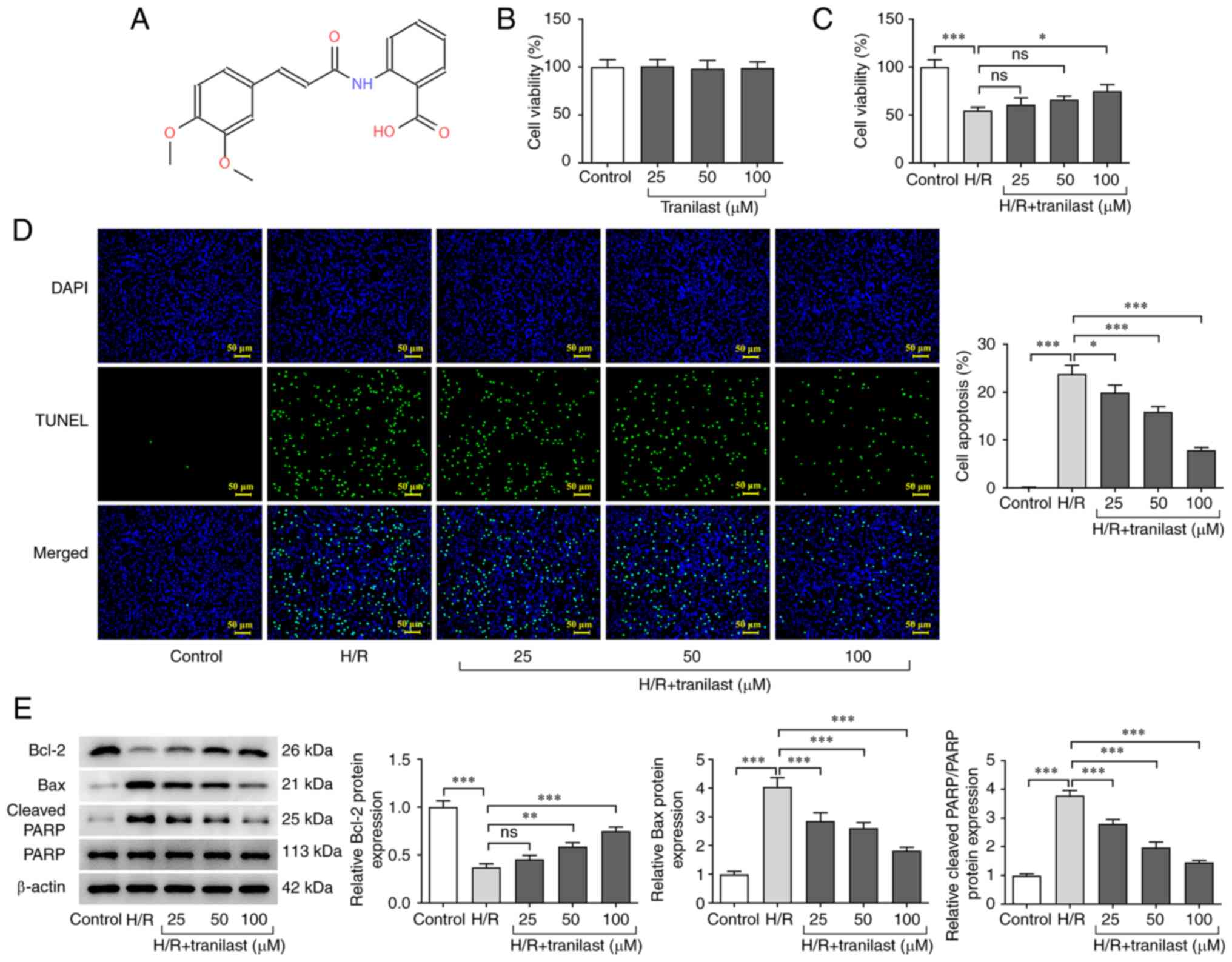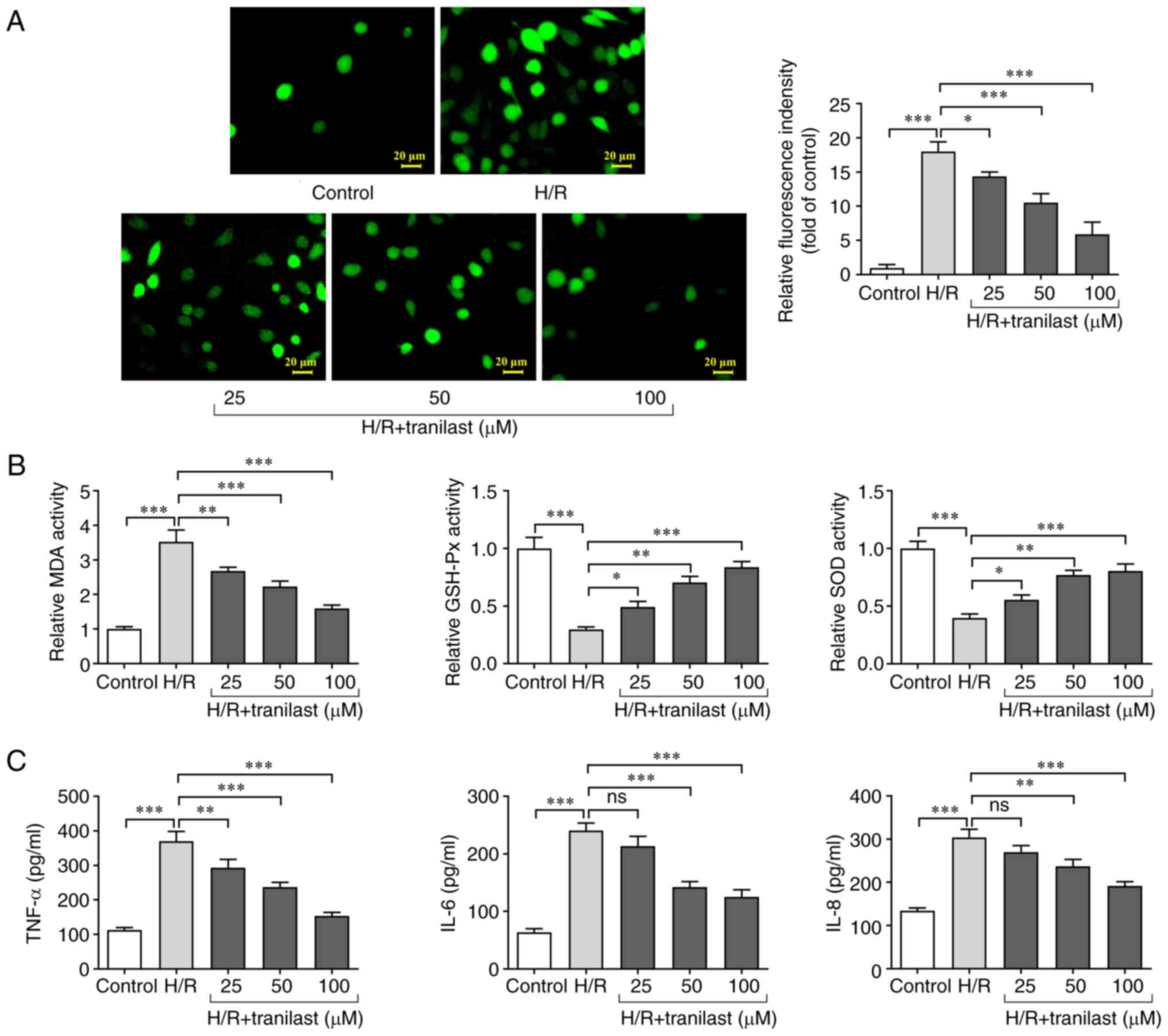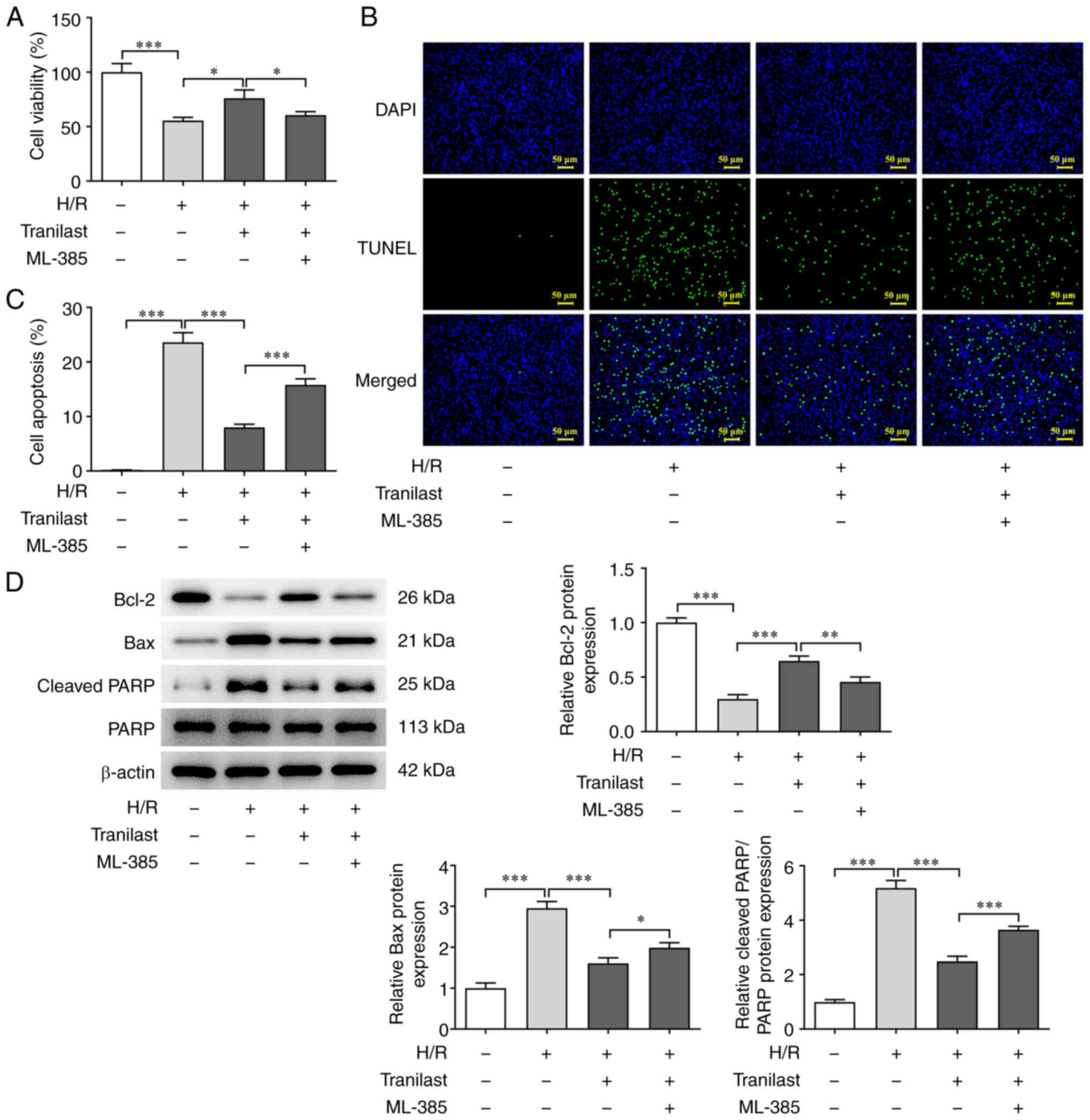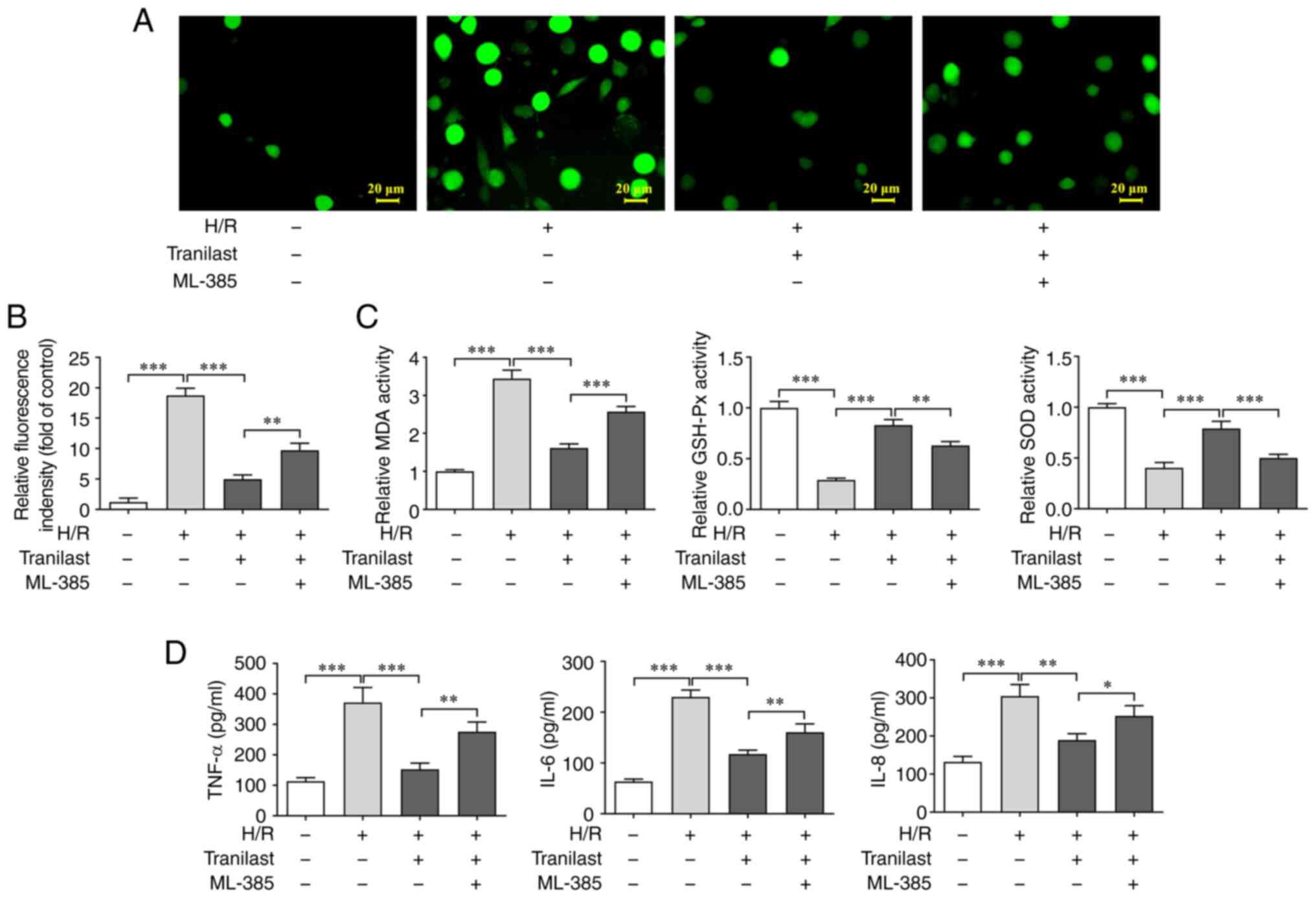|
1
|
Kang IS and Kwon K: Potential application
of biomimetic exosomes in cardiovascular disease: Focused on
ischemic heart disease. BMB Rep. 55:30–38. 2022.PubMed/NCBI View Article : Google Scholar
|
|
2
|
Chang J, Li B, Li J and Sun Y: The effects
of age, period, and cohort on mortality from ischemic heart disease
in China. Int J Environ Res Public Health. 14(50)2017.PubMed/NCBI View Article : Google Scholar
|
|
3
|
Pop D, Dădârlat A, Zdrenghea M, Zdrenghea
DT and Sitar-Tăut AV: Evolution of cardiovascular risk factors and
ischemic heart disease in an elderly urban Romanian population over
the course of 1 year. Clin Interv Aging. 8:1497–1503.
2013.PubMed/NCBI View Article : Google Scholar
|
|
4
|
Al-Herz W and Babiker F: Acute intravenous
infusion of immunoglobulins protects against myocardial
ischemia-reperfusion injury through inhibition of caspase-3. Cell
Physiol Biochem. 42:2295–2306. 2017.PubMed/NCBI View Article : Google Scholar
|
|
5
|
Wu XY, Miao L, Zheng R and Fan GW:
Research progress of myocardial ischemia-reperfusion injury. J Clin
Pharmacol. 32(1043)2016.(In Chinese).
|
|
6
|
Isaji M, Aruga N, Naito J and Miyata H:
Inhibition by tranilast of collagen accumulation in hypersensitive
granulomatous inflammation in vivo and of morphological changes and
functions of fibroblasts in vitro. Life Sci. 55:Pl287–P1292.
1994.PubMed/NCBI View Article : Google Scholar
|
|
7
|
Sun M and Hou M: Research progress of
clinical application of Trinistast. Chin J Dermatovenereology
Integr Trad Western Med. 17:87–90. 2018.(In Chinese).
|
|
8
|
Osman S, Raza A, Al-Zaidan L, Inchakalody
VP, Merhi M, Prabhu KS, Abdelaziz N, Hydrose S, Uddin S and Dermime
S: Anti-cancer effects of Tranilast: An update. Biomed
Pharmacother. 141(111844)2021.PubMed/NCBI View Article : Google Scholar
|
|
9
|
Pfab T and Hocher B: Tranilast and
hypertensive heart disease: Further insights into mechanisms of an
anti-inflammatory and anti-fibrotic drug. J Hypertens. 22:883–886.
2004.PubMed/NCBI View Article : Google Scholar
|
|
10
|
Zhan C, Bai N, Zheng M, Wang Y, Wang Y,
Zhang L, Li J, Li G, Zhao H, Liu G, et al: Tranilast prevents
doxorubicin-induced myocardial hypertrophy and angiotensin II
synthesis in rats. Life Sci. 267(118984)2021.PubMed/NCBI View Article : Google Scholar
|
|
11
|
Li X, Liu J and Shang X: Effect of
tranilast on myocardial fibrosis in diabetes rats through
TGF-β/Smad pathway. Minerva Med. 112:153–154. 2021.PubMed/NCBI View Article : Google Scholar
|
|
12
|
Zhuo Y and Zhuo J: Tranilast treatment
attenuates cerebral ischemia-reperfusion injury in rats through the
inhibition of inflammatory responses mediated by NF-κB and PPARs.
Clin Transl Sci. 12:196–202. 2019.PubMed/NCBI View Article : Google Scholar
|
|
13
|
Qu D, Guo H and Xu Y: Effects of tranilast
on inflammasome and macrophage phenotype in a mouse model of
myocardial infarction. J Interferon Cytokine Res. 41:102–110.
2021.PubMed/NCBI View Article : Google Scholar
|
|
14
|
Li Y, Li Q, Zhang O, Guan X, Xue Y, Li S,
Zhuang X, Zhou B and Miao G: miR-202-5p protects rat against
myocardial ischemia reperfusion injury by downregulating the
expression of Trpv2 to attenuate the Ca2+ overload in
cardiomyocytes. J Cell Biochem. 120:13680–13693. 2019.PubMed/NCBI View Article : Google Scholar
|
|
15
|
Ma W, Li C, Yin S, Liu J, Gao C, Lin Z,
Huang R, Huang J and Li Z: Novel role of TRPV2 in promoting the
cytotoxicity of H2O2-mediated oxidative stress in human hepatoma
cells. Free Radic Biol Med. 89:1003–1013. 2015.PubMed/NCBI View Article : Google Scholar
|
|
16
|
Liu K, Wang F, Wang S, Li WN and Ye Q:
Mangiferin attenuates myocardial ischemia-reperfusion injury via
MAPK/Nrf-2/HO-1/NF-κB in vitro and in vivo. Oxid Med Cell Longev.
2019(7285434)2019.PubMed/NCBI View Article : Google Scholar
|
|
17
|
Zhuang T, Li S, Yi X, Guo S, Wang Y, Chen
J, Liu L, Jian Z, Gao T, Kang P and Li C: Tranilast directly
targets NLRP3 to protect melanocytes from keratinocyte-derived
IL-1β under oxidative stress. Front Cell Dev Biol.
8(588)2020.PubMed/NCBI View Article : Google Scholar
|
|
18
|
Wen C, Xie G, Zeng P, Huang LF and Chen
CY: Tranilast inhibits myocardial fibrosis in mice with viral
myocarditis. Zhongguo Dang Dai Er Ke Za Zhi. 18:446–454.
2016.PubMed/NCBI View Article : Google Scholar : (In Chinese).
|
|
19
|
Pae HO, Jeong SO, Koo BS, Ha HY, Lee KM
and Chung HT: Tranilast, an orally active anti-allergic drug,
up-regulates the anti-inflammatory heme oxygenase-1 expression but
down-regulates the pro-inflammatory cyclooxygenase-2 and inducible
nitric oxide synthase expression in RAW264.7 macrophages. Biochem
Biophys Res Commun. 371:361–365. 2008.PubMed/NCBI View Article : Google Scholar
|
|
20
|
Chen S, Wang Y, Pan Y, Liu Y, Zheng S,
Ding K, Mu K, Yuan Y, Li Z, Song H, et al: Novel role for tranilast
in regulating NLRP3 ubiquitination, vascular inflammation, and
atherosclerosis. J Am Heart Assoc. 9(e015513)2020.PubMed/NCBI View Article : Google Scholar
|
|
21
|
Shiota N, Kovanen PT, Eklund KK, Shibata
N, Shimoura K, Niibayashi T, Shimbori C and Okunishi H: The
anti-allergic compound tranilast attenuates inflammation and
inhibits bone destruction in collagen-induced arthritis in mice. Br
J Pharmacol. 159:626–635. 2010.PubMed/NCBI View Article : Google Scholar
|
|
22
|
Tan SM, Zhang Y, Cox AJ, Kelly DJ and Qi
W: Tranilast attenuates the up-regulation of
thioredoxin-interacting protein and oxidative stress in an
experimental model of diabetic nephropathy. Nephrol Dial
Transplant. 26:100–110. 2011.PubMed/NCBI View Article : Google Scholar
|
|
23
|
Jian J, Xuan F, Qin F and Huang R: The
antioxidant, anti-inflammatory and anti-apoptotic activities of the
bauhinia championii flavone are connected with protection against
myocardial ischemia/reperfusion injury. Cell Physiol Biochem.
38:1365–1375. 2016.PubMed/NCBI View Article : Google Scholar
|
|
24
|
Hu R, Chen ZF, Yan J, Li QF, Huang Y, Xu
H, Zhang XP and Jiang H: Endoplasmic reticulum stress of
neutrophils is required for ischemia/reperfusion-induced acute lung
injury. J Immunol. 195:4802–4809. 2015.PubMed/NCBI View Article : Google Scholar
|
|
25
|
Sani M, Ghanem-Boughanmi N, Gadacha W,
Sebai H, Boughattas NA, Reinberg A and Ben-Attia M: Malondialdehyde
content and circadian variations in brain, kidney, liver, and
plasma of mice. Chronobiol Int. 24:671–685. 2007.PubMed/NCBI View Article : Google Scholar
|
|
26
|
da Cunha MJ, da Cunha AA, Loureiro SO,
Machado FR, Schmitz F, Kolling J, Marques EP and Wyse ATS:
Experimental lung injury promotes changes in oxidative/nitrative
status and inflammatory markers in cerebral cortex of rats. Mol
Neurobiol. 52:1590–1600. 2015.PubMed/NCBI View Article : Google Scholar
|
|
27
|
Treviño S, Aguilar-Alonso P, Flores
Hernandez JA, Brambila E, Guevara J, Flores G, Lopez-Lopez G,
Muñoz-Arenas G, Morales-Medina JC, Toxqui V, et al: A high calorie
diet causes memory loss, metabolic syndrome and oxidative stress
into hippocampus and temporal cortex of rats. Synapse. 69:421–433.
2015.PubMed/NCBI View Article : Google Scholar
|
|
28
|
Wang H, Zhou H, Duan X, Jotwani R,
Vuddaraju H, Liang S, Scott DA and Lamont RJ: Porphyromonas
gingivalis-induced reactive oxygen species activate JAK2 and
regulate production of inflammatory cytokines through c-Jun. Infect
Immun. 82:4118–4126. 2014.PubMed/NCBI View Article : Google Scholar
|
|
29
|
Sundd P, Gladwin MT and Novelli EM:
Pathophysiology of sickle cell disease. Annu Rev Pathol.
14:263–292. 2019.PubMed/NCBI View Article : Google Scholar
|
|
30
|
Wang T, Chen C, Yang L, Zeng Z and Zhao M:
Role of Nrf2/HO-1 signal axis in the mechanisms for oxidative
stress-relevant diseases. Zhong Nan Da Xue Xue Bao Yi Xue Ban.
44:74–80. 2019.PubMed/NCBI View Article : Google Scholar
|
|
31
|
Cheng L, Jin Z, Zhao R, Ren K, Deng C and
Yu S: Resveratrol attenuates inflammation and oxidative stress
induced by myocardial ischemia-reperfusion injury: Role of Nrf2/ARE
pathway. Int J Clin Exp Med. 8:10420–10428. 2015.PubMed/NCBI
|
|
32
|
Konrad FM, Knausberg U, Höne R, Ngamsri KC
and Reutershan J: Tissue heme oxygenase-1 exerts anti-inflammatory
effects on LPS-induced pulmonary inflammation. Mucosal Immunol.
9:98–111. 2016.PubMed/NCBI View Article : Google Scholar
|
|
33
|
Dong S, Xu S, Hou X, Luo D, Chen J and Liu
X: Anti-inflammatory and anti-oxidative protective effects of Nrf2
activation on AGEs-induced hippocampal damage in rats. Stroke Nerv
Dis. 24:388–392. 2017.
|
|
34
|
Kono H, Nakagawa K, Morita S, Shinoda K,
Mizuno R, Kikuchi E, Miyajima A, Umezawa K and Oya M: Effect of a
novel nuclear factor-κB activation inhibitor on renal
ischemia-reperfusion injury. Transplantation. 96:863–870.
2013.PubMed/NCBI View Article : Google Scholar
|



















